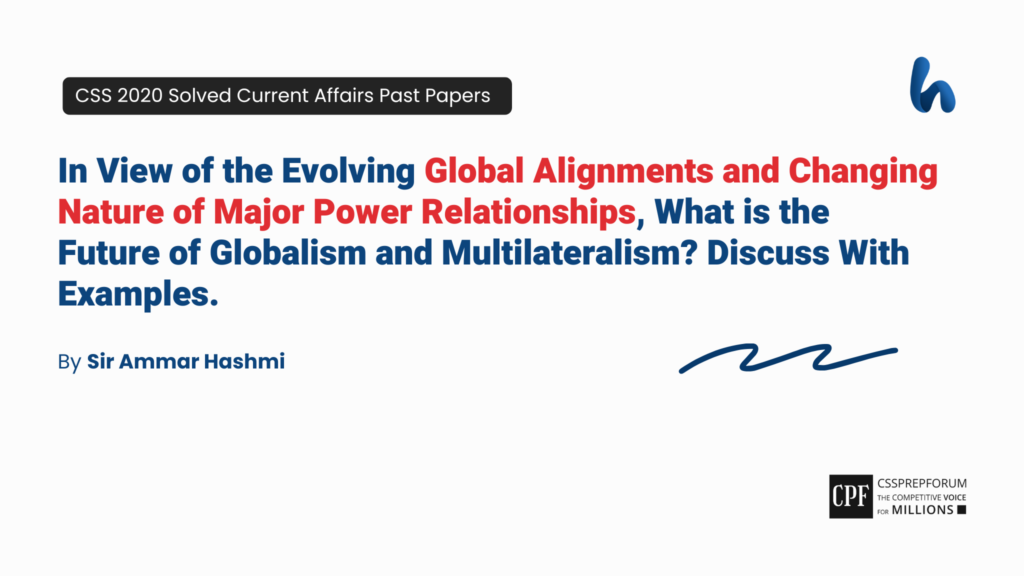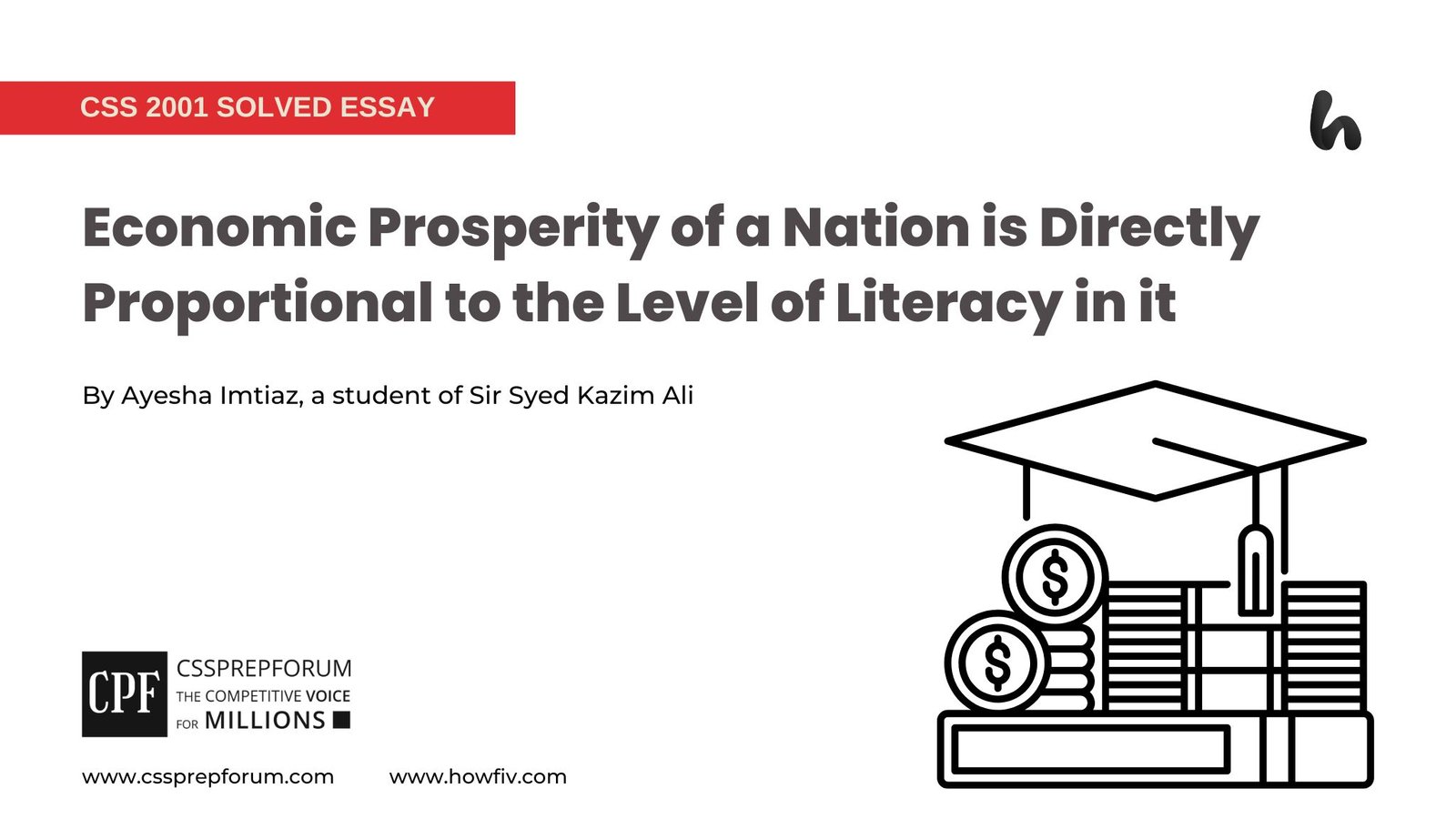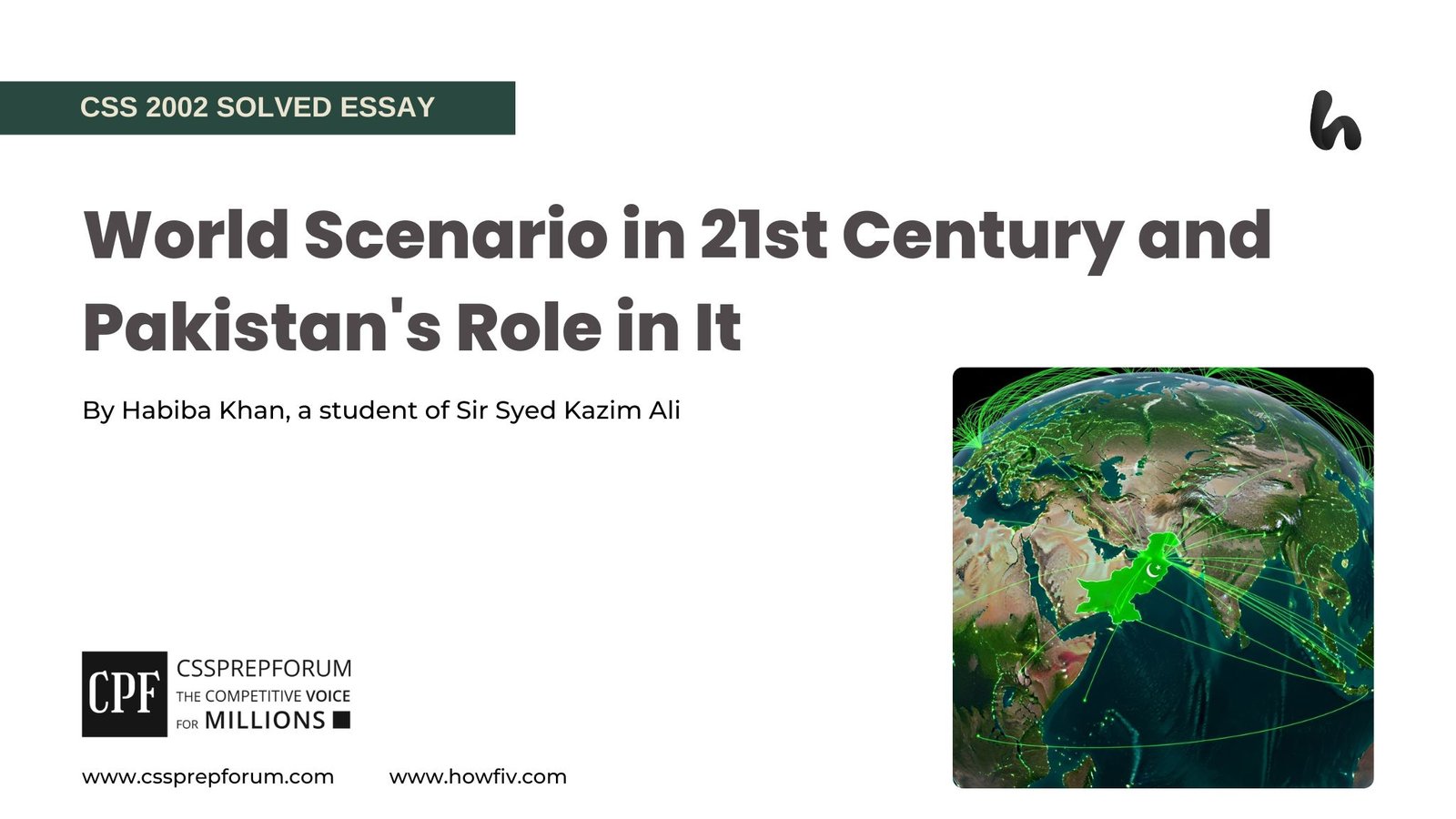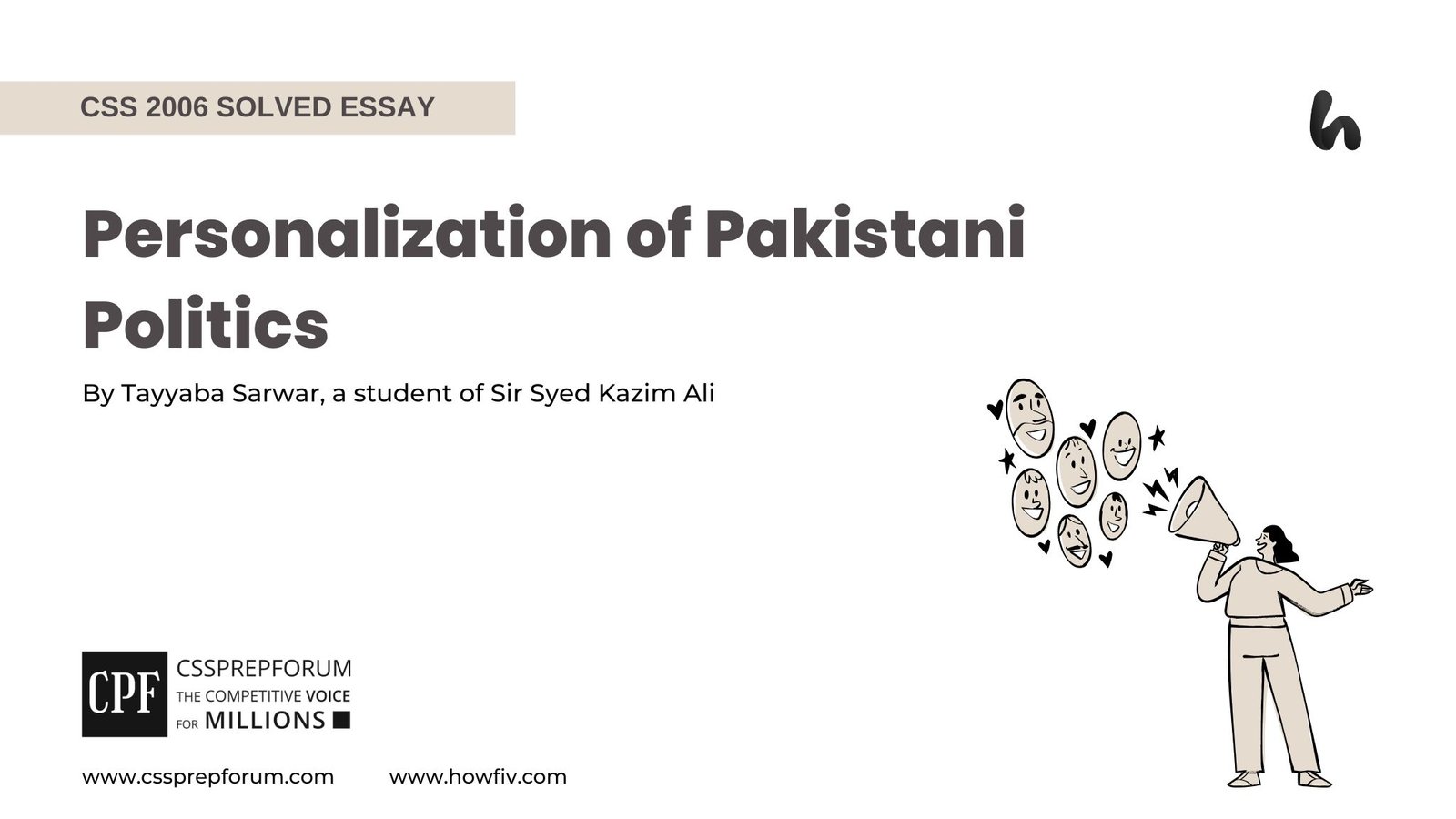CSS 2020 Solved Current Affairs Past Papers | Future of Globalism and Multilateralism
The following question of CSS Current Affairs 2020 is solved by Sir Ammar Hashmi, the best Current Affairs Coach, on the guided pattern of Sir Syed Kazim Ali, which he taught to his students, scoring the highest marks in compulsory subjects for years. This solved past paper question is uploaded to help aspirants understand how to crack a topic or question, how to write relevantly, what coherence is, and how to include and connect ideas, opinions, and suggestions to score the maximum.

Question Breakdown
This question has one part. It requires discussion about the future of globalism and multilateralism, keeping in view the evolving global alignments and changing major power relationships.
Outline
1-Introduction
2-An Overview of Globalism and Multilateralism
3-New Trends of Globalism
4-The Future of Globalism and Multilateralism
- ✓Interconnectedness Among the Nations
- CPEC, an elegant case study, as the promoter of connectivity in the region
- ✓Rise of the non-western and emerging economies
- Taiwan and India have risen to become among the better economies of the world
- ✓Digital Globalization and The New World
- 5G technology in Pakistan and other countries, making the globe a digitally connected network
- ✓Ensured Energy and Food Security
- India- Russia oil trade and South Africa-Russia wheat trade, alleviating food and energy crises
- ✓Cultural Promotion Among the Nations
- The U.S.A.’s cultural programs, such as the YES program, promote people from Asia and other regions to learn from Western countries
- ✓Strengthened International Institutions
- International institutions, like WB, IMF, and WTO, working to improve the economic, political, and social conditions of the world
5-Critical Analysis
6-Conclusion

Answer to the Question
Introduction
Since the creation of the world, men have been dependent upon each other in almost all aspects of human life, be they political, social, cultural, or economic. From the Stone Age till now, the survival of man has become possible because of collaboration and cooperation among human beings. They have faced the hardships of the world: storms, rains, extreme cold, and many more, together. If they had not cooperated and lived with mutual understanding, they would not have survived for a few decades. The same can be applied to the countries in today’s world. For instance, in the beginning, when the countries were not cooperative, many wars, such as WWI and WWII, happened; however, as time passed, the states learned they had no other option but to cooperate. Since then, especially in the twentieth and twenty-first centuries, cooperation has increased by leaps and bounds, with many countries amalgamating into different alliances for a better future.
An Overview of Globalism and Multilateralism
To begin with, it is imperative to discuss what globalism and multilateralism mean. Richard Hass has shed some light on globalism and literalism in his publications. Previously, the world was divided into two main poles: the U.S.A. and the USSR. However, with the rise of the non-western economies, non-state actors, emerging geo-economic alliances, and the failure of the previous powers to maintain their hegemony, literalism has expanded from two multilateralism to globalism. Now, the world is multi-polar, multi-lateral and more globalized than it used to be.
Trends of Globalism and Multilateralism
Further, the trends of globalism and multilateralism have changed many folds in the twenty-first century. Unlike in the past, when the world was divided between the two extreme powers, the Capitalist U.S.A. and the Communist USSR, today’s world is no longer under the hegemony of these two powers despite their sanctions and coercive diplomacy. Today’s world is a globalized world, where alliances are not just for the sake of security but for socio-economic cooperation. For example, the Conference of Parties and the Paris Agreement, unlike NATO and the Warsaw Pact in the past, are focused on achieving sustainable development goals rather than being a military alliance as in the past.
The Bright Future of Globalism and Multilateralism
Moreover, how multilateralism and globalism will be in the future can be easily predicted by looking at their blooms in the current era and prospects in the future. For instance, if seen through the prism of connectivity among the nations in social, political, and economic spheres, globalism and multilateralism seem to bear fruit shortly. If they prevail as they are now, one can predict a better future for humankind. One of the most significant examples of connectivity is China’s Belt and Road Initiative, connecting more than 160 countries directly and indirectly. The initiative aims at connecting the global world culturally, socially, politically, and economically. This shows globalism and multilateralism are heading towards prosperity and development for the whole world.
Second, globalism and multilateralism have made the world more inclusive. Unlike in the past, when emerging and developing economies had little say in global affairs, today’s multilateralism enables and values these nations. For example, the G20 and the SAARC organizations are a few examples of these nations growing collectively. Similarly, Taiwan has emerged as one of the leading Tech Industries in the world. Besides its geo-political importance, its say in global affairs has gained much value. It plays a vital role in shaping the geopolitics of the South China Sea. Thus, it can be seen from these examples as to how globalism and multilateralism have given a platform.
Third, globalism and multilateralism have adopted new forms, such as digital globalism, in the present era. In contrast to traditional globalism, which is cooperation among countries in social, political, and cultural spheres, digital globalism promotes technological collaboration, the need of an hour, among nations, making the world an interconnected network. For instance, Robotics, mechatronics, 5G, and last but not least, AI technologies have changed the world’s picture tremendously. Now, the world is more connected than it was in the past.
Fourth, globalism and multilateralism have also made many food-insecure countries self-sufficient to meet their demands for food. South Africa and Russia have been involved in the wheat trade to cope with their food requirement. Their wheat trade, as of now, has increased by twenty per cent. Similarly, globalism and multilateralism have also been lessening energy insecurity. India-Iran oil trade, Qatar oil agreements, and Pak-Russia oil agreements show how globalism and multilateralism have been involved in reducing the burden of energy insecurity of many nations worldwide.
Fifth, not only do globalism and multilateralism work for political and economic cooperation, but they also promote social and cultural connectivity. As exemplified, the U.S.A.’s artistic programs, such as the ‘YES’ Program and Pakistan’s CPSP- POST IMM scholarships program to different countries, where the students learn about those countries, their cultures, societies, values, and many more. Moreover, these programs help students in their education, research work, and career building, thus making the world more inclusive and interconnected.
Last, internationalism, instead of regionalism and nationalism, has been the sole moto behind globalism and multilateralism. They aim to promote international and transborder connectivity, making humanity worldwide cooperative and prosperous. In this respect, international institutions have been working worldwide to promote peace, economic connectivity, justice, and sustainable growth. For instance, G20, G7, and BRICS are some of the international organizations that have taken up the task of internationalization. Looking at all these prospects and pros of globalism and multilateralism, one can predict a better and more fruitful future for the world.
Critical Analysis
Critically, it is evident from the above arguments that globalism and multilateralism are the future of the world. Looking at their prospects, one can understand the benefits globalism and multilateralism bring with them. From only economic and military connectivity in the past, today, the world has emerged as a socially, politically, culturally, and digitally interconnected world. Further, the wave of internationalism has added fertilizers to the fertile soil of globalism and multilateralism. Therefore, if globalism and multilateralism keep the same pace and within the international ethics and laws, that day is not far when all the people will live happily and prosperous.
Conclusion
To conclude, unlike in the past, when the world was divided into parts based on regionalism and nationalism, globalism and multilateralism have altered the basic structure of the world’s functioning. Today’s world is more connected in terms of military and economic aspects, socially, politically, and digitally. This connectivity brings many prospects and hopes for humanity: countries are collaborating to secure energy and food, people are becoming socially connected, and the world now seems more like a network than it previously was.
CSS Solved Past Papers’ Essays
Looking for the last ten years of CSS and PMS Solved Essays and want to know how Sir Kazim’s students write and score the highest marks in the essays’ papers? Then, click on the CSS Solved Essays to start reading them.
CSS Solved Essays
CSS Solved General Science & Ability Past Papers
Want to read the last ten years’ General Science & Ability Solved Past Papers to learn how to attempt them and to score high? Let’s click on the link below to read them all freely. All past papers have been solved by Pakistan’s top CSS GSA coach having the highest score of their students.
General Science & Ability Solved Past Papers












